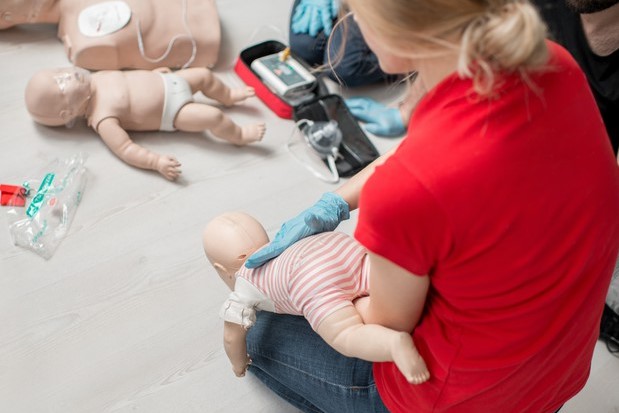
What Is Choking? Causes, Treatment, and Prevention
Choking happens when something—food or another item—is caught in the back of the throat. If the object (or food) blocks the top of the trachea a person may be unable to breathe
This is an emergency. It is also possible that food or other things can get stuck in the esophagus; while painful, this does not cause a person to stop breathing.
Causes of Choking
Certain medical conditions or circumstances can make a person more likely to choke. Risk factors include (but are not limited to):
- Children under the age of 5 1
- The elderly 2
- People with neurological illnesses
- People with diseases that cause muscular degeneration, such as multiple sclerosis3
- Disorders of the esophagus such as a narrowed esophagus due to chronic acid reflux (GERD)
- People with anatomical genetic abnormalities that affect the swallowing process (cleft lip for example)
- People with injuries that affect the swallowing process
Additionally, certain activities or habits can also increase your risk of choking:
- Eating too quickly
- Not sitting down while eating
- Not chewing food properly
- Eating while lying down
Prevention
Children under the age of 5 have an increased risk of choking.1
Both cognitive development and anatomic differences in children cause an increased risk in this age group.
Small children lack the ability to differentiate what objects may get stuck in their throats.
This is often during their oral phase of development when they put everything into their mouths.
As your child gets older, they still remain at risk due to their smaller airway.
The risk, however, decreases because cognitively, they become more aware of which items are safe to put in their mouths.
While completely child-proofing your home is near impossible, keeping certain objects away from small children can go a long way toward preventing choking.
Similarly, older people also have an increased risk of choking.
Choking in the elderly can be caused by a loss of muscle strength in the throat and weaker or missing teeth.
Older people should take smaller bites and make sure to chew food thoroughly.
Eating slowly and removing distractions from the eating area can also help reduce the risk of choking.
Common Choking Hazards
- Latex balloons – leading cause of death in children under the age of 6
- Balls
- Marbles
- Coins (18% of choking-related ED visits for children 1 to 4 years old)5
- Disc batteries (also called button batteries and are especially dangerous because when swallowed there is a possibility they will leak toxic alkaline contents into the digestive tract.)
- Small toys – some say that if an object can fit inside a roll of toilet paper your child can choke on it.
- Caps (pen or marker caps especially)
- Safety pins
- High-Risk Foods
- Hot dogs – most common fatal food-related hazard
- Hard candy – (19% of choking-related emergency room visits)6
- Grapes
- Nuts
- Raw carrots
- Apples
- Marshmallows
- Popcorn
- Peanut butter
Approximately 60% of non-fatal choking hazards are caused by food items.6
Foods that are choking hazards are foods that can be compressed to fit the size of the airway.
In addition to the foods listed above, you should not give a small child, elderly person or any individual who has difficulty swallowing, foods that are difficult to chew or are a size or shape that will easily become compressed in the airway.
Supervision is also one of the single most important factors to help prevent choking.
One hundred percent supervision is usually not possible but should be implemented as much as possible when children under 5, elderly persons, or a person with a history of swallowing difficulties are eating.
Keeping small objects out of reach and purchasing appropriate age level toys can also help prevent non-food related choking.
Also, not allowing children to run and play while eating food or candy can help prevent choking on food.
Some other good prevention tips include:7
- Eating food only at the table
- Cooking vegetables until they are soft
- Cutting hotdogs and other food items into pieces that are less than 1/2 inch and avoid cutting into round shapes
- Encouraging adequate chewing – this might not be mastered until your child is 4 years old
- Limiting distractions while eating
- Having a drink available while eating – avoid swallowing food and liquid at the same time
- Some individuals with swallowing problems (dysphagia) should only drink thickened liquids
What Should I Do If Someone Is Choking?
If someone is choking, you should determine whether or not they can talk.
If they can talk, cough or make other noises that indicate air passage, let them clear their airway on their own.
Intervention at this point may cause further lodging of the object to occur.8
If an individual has something caught in the esophagus they will still be able to speak and breathe but it may be painful, especially when swallowing.
They may also drool. You should seek medical attention so the object can either be retrieved or pushed into the stomach/intestines using a scope (EGD).
The Heimlich Maneuver
If the person choking is not able to speak or make other noises, they will not be able to breathe either.
An indication that a person is not breathing is cyanosis.
This is an emergency. You should start abdominal thrusts, also known as the Heimlich maneuver.8
To perform the Heimlich maneuver, follow these steps:
- Stand behind the person who is choking. Put one leg between the person’s legs.
- If the person is a child, make sure you are at their level with your head to one side.
- Wrap your arms around the person and place the thumb side of your fist just above their belly button.
- Grab your fist with your other hand. Thrust quickly into the person’s stomach in an upward motion.
- Do this five times. Repeat until the object is expelled.
- If the object is not expelled and the person loses consciousness, begin CPR.
CPR
If the person at any point becomes unresponsive (unconscious), you should begin CPR. If you are not alone, have someone else call Emergency Number.
If you are alone call Emergency Number immediately and (if possible) stay on the line while performing CPR.
Follow these steps:
- Place the person on their back.
- Place one hand on the person’s chest directly between the nipples. Place the other hand on top of the first.
- Push hard and fast on the chest to a depth of about 2 inches. Make sure to lift your weight off the chest between compressions.
- If you are trained in CPR, you should perform 30 chest compressions followed by two rescue breaths.
- If you are untrained in CPR, you should perform only chest compressions (100 to 120 per minute).
Prevention is key when it comes to choking.
Educating yourself on common causes of choking can help prevent complications from occurring and keep your loved ones safe.
References:
- Sidell DR, Kim IA, Coker TR, Moreno C, Shapiro NL. Food choking hazards in children. Int J Pediatr Otorhinolaryngol. 2013;77(12):1940-6. doi:10.1016/j.ijporl.2013.09.005
- Kramarow E, Warner M, Chen LH. Food-related choking deaths among the elderly. Inj Prev. 2014;20(3):200-3. doi:10.1136/injuryprev-2013-040795
- Ghasemi N, Razavi S, Nikzad E. Multiple Sclerosis: Pathogenesis, Symptoms, Diagnoses and Cell-Based Therapy. Cell J. 2017;19(1):1–10. doi:10.22074/cellj.2016.4867
- St Louis Children’s Hospital. Why are Latex Balloons a Danger to Children? 2020.
- Walner D, Wei J. Preventing choking in children. AAP News. 2011; 32(4)16.
- CDC. Nonfatal Choking-Related Episodes for Children 0 to 14 years of Age. 2002.
- Committee on Injury, Violence, and Poison Prevention. Prevention of choking among children. Pediatrics. 2010;125(3):601-7. doi:10.1542/peds.2009-2862
- Kleinman ME, Brennan EE, Goldberger ZD, et al. Part 5: Adult Basic Life Support and Cardiopulmonary Resuscitation Quality: 2015 American Heart Association Guidelines Update for Cardiopulmonary Resuscitation and Emergency Cardiovascular Care. Circulation. 2015;132(18 Suppl 2):S414-35. doi:10.1161/CIR.0000000000000259
Read Also:
Emergency Live Even More…Live: Download The New Free App Of Your Newspaper For IOS And Android
How Healthcare Providers Define Whether You’re Really Unconscious
Concussion: What It Is, What To Do, Consequences, Recovery Time
First Aid: The Causes And Treatment Of Confusion
Know What To Do In Case Of Choking With Child Or Adult
Choking Children: What To Do In 5-6 Minutes?



